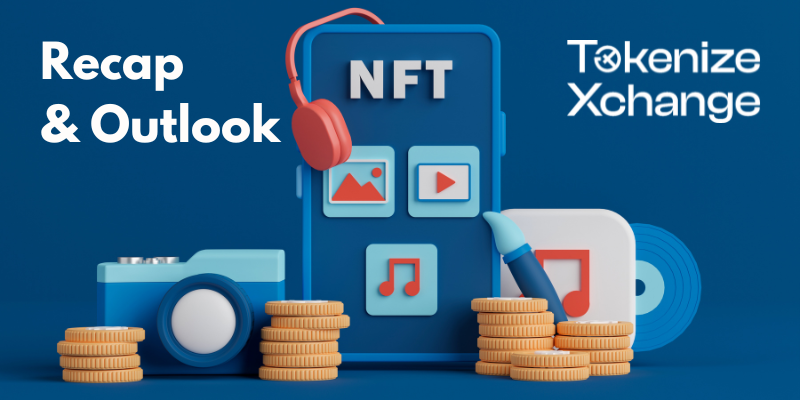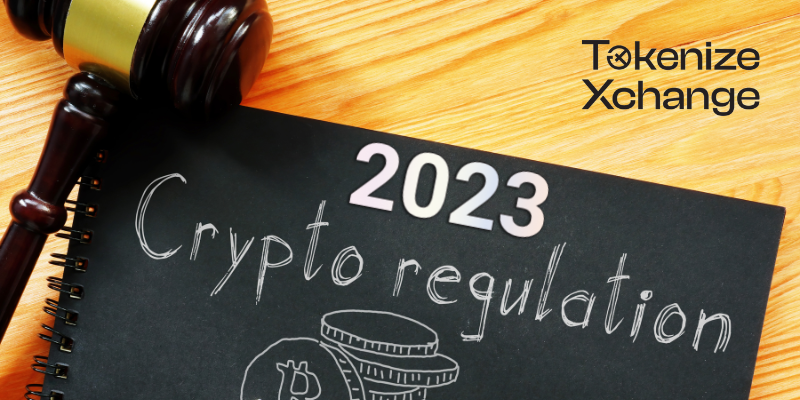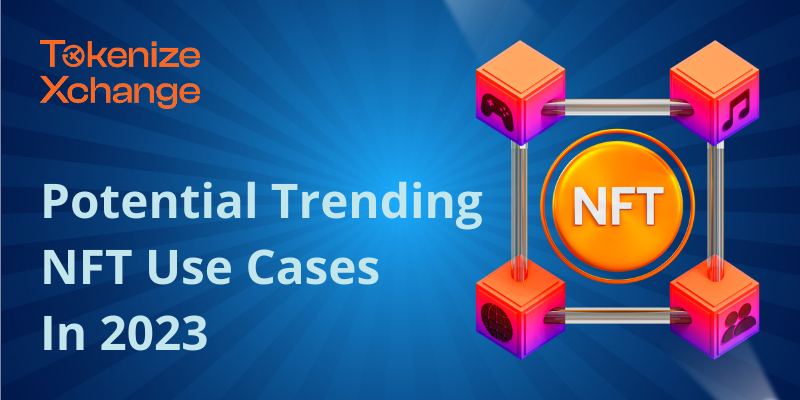
NFTs, or Non-Fungible Tokens, are digital assets that are stored on a blockchain and can be used to represent a variety of things, such as and not limited to digital art, gaming, music, real estate and virtual property. NFT allows for the creation of a verifiable record of ownership and authenticity. In 2021, NFT took the world by storm by hitting $17.6 billion, an increase of 21,000% from $82 million in 2020. In 2022, the market saw a slowdown due to the overall bear market.
Despite this, artists and creators found ways to continue generating revenue and NFT collectors have become prominent builders in the web3 space. This includes the growth of music and photography NFTs, and advancements in blockchain technology have helped solidify a number of promising NFT use cases that have the potential to shape the metaverse. In 2023, these sectors are worth keeping an eye on.
Interesting facts about NFT
If you don’t know what is NFT, here are some stats and facts to share.
- The infographic below shows the number of NFT holders in 2022.

- In March 2021, Sina Estavi, an Iranian-based crypto enthusiast, bought an NFT of Twitter founder Jack Dorsey’s first-ever tweet for a whopping $2.9 million.
- In March 2021, a digital artwork by Beeple sold for $69.3 million at a Christie’s auction.
- NFT sales have grown 131 times from the first quarter of 2020 to the first quarter of 2021, which saw $2 billion in sales.
- The first known NFT was called “Quantum”, created in May 2014 by Kevin McCoy and Anil Dash and consisted of a video clip made by McCoy’s wife. It was sold to Dash for $4 during a live presentation at a conference.
- While NFTs can sell for a few dollars to millions, roughly 50% of all recorded sales are under $200, making the average price for most NFTs relatively low.
- The average cost of minting and selling an NFT is between $70 and $120 but can go into the thousands.
- Artworks and collectibles are the two most popular categories in NFTs.
- China is the country with the biggest interest in NFT opportunities。
- OpenSea is the largest NFT marketplace.
Recapping 2022
The year 2022 was marked by significant events that have had a major impact on the cryptocurrency ecosystem. It’s worth reflecting on the most significant events of the year and considering what the future holds for the crypto industry in 2023.
- Q1: ATH trading volume for the NFT market.
- Q2: Increase in bankruptcies incidents among cryptocurrency companies. Crash of Terra LUNA.
- Q3: Crypto recovery phase. Increased attention on Ethereum’s upgrade – The Merge. Cryptocurrencies managed to close October on a positive note, albeit at a low rate.
- Q4: The collapse of FTX deals a major setback and turmoil to the crypto sector; Bitcoin suffers a significant low at $15,000 and has been flat at $16,000 since then.
2023 – Year of regulation

The effects of negative events that occurred in 2022 are expected to continue into 2023. Market analysts believe that the interconnectedness of crypto companies could lead to a domino effect.
Countries that have not yet regulated the crypto market may take action in 2023 to control it, especially as individual investors have also suffered significant losses. The possibility of the crypto sector affecting traditional finance has also been cited as a reason for increased regulation.
It’s worth noting that even though institutional investors have left the market in large numbers in 2022, many financial institutions have decided to expand their services into the crypto space, and established various strategic partnerships.
The actions of these companies in 2023 may bring institutional money back to the crypto space, depending on the economic conditions. However, it should also be noted that the difficulties faced in 2022 are likely to continue in 2023, with the overall crypto and NFT industry likely to still be under pressure due to liquidity shortages and the fear of contagion.
Unique NFT Use Cases To Highlight in 2023

- Ticketing
By using NFT tickets, both the issuer and the holder can gain advantages. The issuer can track attendance accurately by using blockchain as a record-keeping system and also have new opportunities for engagement with ticket holders through NFTs. This can include sending notifications, offering promotions, providing access to exclusive content or services, and more by analyzing data connected to NFT ticket holders.
- Gaming
The Metaverse game Sandbox is comparable to the wildly popular Sandbox games Minecraft as well as Roblox. Players, just as in earlier games, may personalize their environments and communicate with one another. In order to create unique scenarios on Sandbox, users must first acquire LAND NFT games. The ability to construct is what sets Sandbox apart. Maker Games makes tools like the Game Maker and Voxel Editor available to programmers and artists. They may create games as well as content for use inside games using these technologies.
- Membership Passes
An early use case of NFT membership is the Bored Ape Yacht Club. Owners of a BAYC NFT are granted access to merchandise releases, music events, additional NFT releases, and more. Projects like LinksDAO, LoudPunx, and Flyfish Club remain two of the most ambitious membership endeavours, while platforms like Friends With Benefits and OneOf serve as models for organizations looking to introduce membership passes. Oftentimes, NFT memberships are enforced via “token-gating,” which uses blockchain tech to verify ownership of an NFT and grant holders access to whatever member-exclusive perks are on offer. This can be implemented in Discord servers, at in-person or virtual events, and more.
- Soulbound Tokens
Soulbound Tokens (SBTs), proposed by Vitalik Buterin, are a type of NFT that cannot be transferred, making them useful for maintaining permanent records. Instead of relying on traditional methods such as paper records which are prone to be lost or damaged over time, SBTs offer a more secure and reliable method of verifying important information on the blockchain.
- Artificial Intelligence (AI)
Many well-known artists in the NFT field already incorporate AI collaboration into their creative processes. This is not a recent trend, but rather a natural outcome of the digital nature of the NFT industry, where individuals from different backgrounds such as developers, artists and coders come together. It is likely that the influence and reach of AI in society will be more extensive than that of NFTs currently. This also includes its effect on the Web3 ecosystem.
Where to find NFTs?
The best place to buy and sell NFTs is on NFT marketplaces. Some of the most popular marketplaces include OpenSea, Larva Labs, NBA Top Shot, Rarible, Nifty Gateway, and Mintable.

Below is the overview of Top Marketplaces for NFTs:
| Market | Average price (USD) | Traders | Volume, billions |
| OpenSea | $938.99 | 1,387,357 | $14.68 |
| Axie Infinity | $216.15 | 1,624,169 | $3.94 |
| CryptoPunks | $123,690.00 | 5,600 | $2.40 |
| NBA Top Shot | $63.63 | 492,039 | $0.78 |
| Magic Eden | $308.74 | 304,403 | $0.62 |
| Solanart | $1,100.00 | 170,703 | $0.59 |
| Mobox | $790.81 | 59,178 | $0.53 |
| AtomicMarket | $24.98 | 895,199 | $0.32 |
| Rarible | $990.79 | 92,115 | $0.28 |
| SuperRare.co | $7,940.00 | 5,493 | $0.21 |

On the more local front, we also have Elemint. Elemint is an NFT platform that was initially launched in Singapore by Tokenize Xchange in March 2022 but is open to use for those in Malaysia and beyond. Elemint aims to mainstream the adoption of NFTs by making it easy for everyone to collect and trade NFTs. There are building tools that allow collectors to trade their items, and tools for creators to launch authentic unique digital works and connect them through Elemint’s vibrant and integrated marketplace. Read more HERE to find out how to get started on Elemint.
Where do I store my NFT?
NFTs are stored in the same way as cryptocurrency, and there are several options for storing them. Your storage options can be a software wallet (soft wallet), or a hardware wallet (hard wallet). Some popular NFT wallets include MetaMask, MyEtherWallet, and Trust Wallet.
These wallets provide secure storage and easy management of NFTs, allowing you to view, buy, sell, and transfer your NFTs with ease. Additionally, NFT marketplaces such as OpenSea, Rarible, and SuperRare, also offer built-in NFT wallets, which enable you to purchase and sell NFTs directly on their platforms.
Final Thoughts
Despite price fluctuations, NFTs continue to rise in popularity and into the mainstream.
The NFT area still has lots of possibilities for expansion in 2023, even though the first surge of enthusiasm has tapered down. There are a number of factors that could drive this growth, including increased mainstream awareness and adoption of NFTs, as well as the emergence of new use cases and applications for these unique digital assets.
As the technology behind NFTs continues to evolve, we can expect to see new features and capabilities that will make it even easier for creators and collectors to use and trade these assets.
Overall, the outlook for NFTs in 2023 is one of excitement and potential, as the world continues to discover the many benefits of this innovative new technology.
